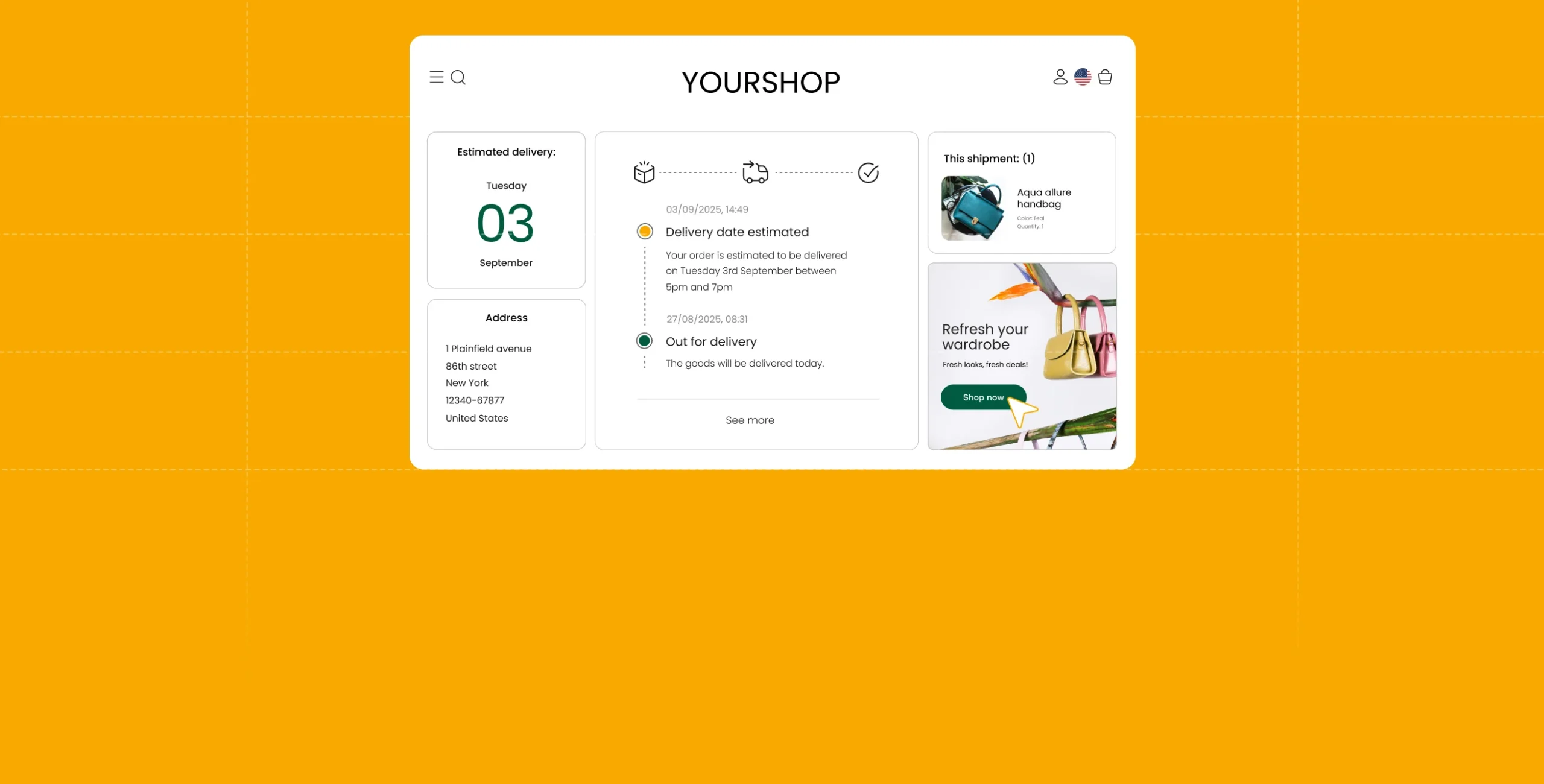Why parcelLab?
Discover why parcelLab is the go-to post-purchase partner for top retailers across the globe

Why parcelLab?
Discover why parcelLab is the go-to post-purchase partner for top retailers across the globe
Why parcelLab
Why top retailers choose parcelLab over the rest
AI and innovation
Transforming post-purchase with AI
PPX maturity curve
Discover where you stand on the curve
PPX Institute
Turn transactional relationships into customers for life
Post-purchase audit
Experience your brand the way your customers do
Platform
Platform support
PLATFORM
Meet the platform
The industry’s first and only PPX platform tailor-made for retailers
WHAT'S NEW
Benchmarking
Benchmark against the industry in real-time
Copilot
Turn delivery anxiety into customer satisfaction with AI
AI Email Editor
Streamline operations and reduce complexity with AI-powered automation
Campaign Manager 2.0
Run campaigns that drive revenue
Smart Survey
Collect feedback and drive improvements


OVERVIEW
Enhance delivery experience
Seize control of your delivery experience
CAPABILITIES
Track & communicate
Keep your customers engaged
Set up a branded tracking portal
Keep customers in your ecosystem
Create personalized journeys
Deliver the right message, at the right time
Run targeted campaigns
Create campaigns that convert
Predict delivery delays
See delivery issues before they happen and take proactive action
Streamline claims management
Reclaim time, revenue, and customer trust
Resolve customer inquiries
Empower your customer service teams

OVERVIEW
Make returns seamless
Transform customer dissatisfaction into revenue retention by digitizing returns and exchanges.
CAPABILITIES
Track and inform returns status
Create a seamless returns experience that retains customers
Self-service returns portal
Let customers register returns with ease
Personalize returns journey
Encourage exchanges over refunds
Forecast returns volume
Anticipate return patterns before they happen
Offer flexible returns
Give your customers versatile return options that cater to their preferences


OVERVIEW
AI-powered post-purchase
Optimize every post-purchase interaction with parcelLab's AI agents
CAPABILITIES
Execute with AI
Harness the power of AI agents
Predict with AI
Stay ahead with real-time insights & forecasts
Simplify with AI
Cut complexity & streamline operations
Personalize with AI
Deliver tailored experiences

Solutions
Reduce WISMO & WISMR calls
Keep customers in the loop & support smarter
Turn returns into revenue
Make returns seamless, maximize revenue
Manage complex post-purchase scenarios
Handle exceptions, claims & logistics
Optimize post-purchase campaigns
Boost engagement & drive conversions
Enhance personalization and engagement
Create 1:1 tailored experiences
Resources
Company

Why parcelLab?
Discover why parcelLab is the go-to post-purchase partner for top retailers across the globe
Why parcelLab
Why top retailers choose parcelLab over the rest
AI and innovation
Transforming post-purchase with AI
PPX maturity curve
Discover where you stand on the curve
PPX Institute
Turn transactional relationships into customers for life
Post-purchase audit
Experience your brand the way your customers do
PLATFORM
Meet the platform
The industry’s first and only PPX platform tailor-made for retailers
WHAT'S NEW
Benchmarking
Benchmark against the industry in real-time
Copilot
Turn delivery anxiety into customer satisfaction with AI
AI Email Editor
Streamline operations and reduce complexity with AI-powered automation
Campaign Manager 2.0
Run campaigns that drive revenue
Smart Survey
Collect feedback and drive improvements

OVERVIEW
Enhance delivery experience
Seize control of your delivery experience
CAPABILITIES
Track & communicate
Keep your customers engaged
Set up a branded tracking portal
Keep customers in your ecosystem
Create personalized journeys
Deliver the right message, at the right time
Run targeted campaigns
Create campaigns that convert
Predict delivery delays
See delivery issues before they happen and take proactive action
Streamline claims management
Reclaim time, revenue, and customer trust
Resolve customer inquiries
Empower your customer service teams

OVERVIEW
Make returns seamless
Transform customer dissatisfaction into revenue retention by digitizing returns and exchanges.
CAPABILITIES
Track and inform returns status
Create a seamless returns experience that retains customers
Self-service returns portal
Let customers register returns with ease
Personalize returns journey
Encourage exchanges over refunds
Forecast returns volume
Anticipate return patterns before they happen
Offer flexible returns
Give your customers versatile return options that cater to their preferences

OVERVIEW
AI-powered post-purchase
Optimize every post-purchase interaction with parcelLab's AI agents
CAPABILITIES
Execute with AI
Harness the power of AI agents
Predict with AI
Stay ahead with real-time insights & forecasts
Simplify with AI
Cut complexity & streamline operations
Personalize with AI
Deliver tailored experiences

Reduce WISMO & WISMR calls
Keep customers in the loop & support smarter
Turn returns into revenue
Make returns seamless, maximize revenue
Manage complex post-purchase scenarios
Handle exceptions, claims & logistics
Optimize post-purchase campaigns
Boost engagement & drive conversions
Enhance personalization and engagement
Create 1:1 tailored experiences
Resources
Company

We took a look at the top 50 DTC retailers operating in the UK to discover what their checkout experiences were like. We discovered that a customer’s choices at checkout are highly constrained. From the type of checkout to the shipping options, DTC retailers are rarely giving their customers a choice.
First, a shocking 52% of brands ONLY offer standard delivery. 38% of brands offer next-day delivery, but only a further 10% offer a more flexible option like click and collect.
Similarly, only 20% of retailers allow customers to choose their carrier. 80% of those 20% charge the customer for that choice.
These numbers are despite research showing that consumers now expect next-day delivery and prefer carrier choice. As a result, most DTC brands are behind the times. In order to remain competitive in the the modern retail landscape, DTC brands must begin implementing immediate change.
A full 34% of UK DTC brands require customers to log in to a customer account to make a purchase. This is despite the fact that guest checkout is extremely important to first-time buyers. Guest checkout reduces cart abandonment because it’s much faster method. It also allows first-time buyers to try a brand out before committing to sharing an excessive amount of personal data.
When it comes to flexible payment methods, DTC brands are also lagging. Only 20% of retailers offer a ‘buy now, pay later’ option. Of those who do, Klarna is the most popular provider. This is in comparison to the wider retail space where 41% of brands offer ‘buy now, pay later’ options. Doing so is an excellent solution for customers who don’t want to pay for an item just to try it out at home. With ‘buy now, pay later’ options, they don’t have to ever part with their money if they return the item.
The biggest blocker to checkout, however, remains shipping costs. 16% of brands are still always charging for shipping. 56% have a minimum order value, but these thresholds are often quite high and still prevent conversions. While always-free shipping may not be possible to offer, brands need to be taking regular audits of their shipping costs and order thresholds to ensure they provide the most competitive thresholds possible.
DTC brands have complete control over their checkout experiences and need to begin removing these obvious conversion blockers.
Despite the fact that many brands in the DTC space tout their commitments to the environment, few brands offer customers sustainable options at checkout. Only 4% offer carbon-neutral delivery as an option. And only 6% offer less packaging as an option at checkout. With more companies popping up devoted entirely to helping retail brands achieve carbon-neutral shipping, DTC brands can quite easily begin implementing changes to put their money where their mouths are. This will help them to stand apart from their competitors.
It’s well known that around 70% of carts are abandoned. Our findings amongst UK DTC brands show some obvious wins that brands can start immediately implementing to improve their conversion rates. DTC brands need to begin putting the customer first by embracing Operations Experience Management. By taking end-to-end ownership of the post-purchase experience, not only can brands improve the post-purchase process as a whole, they can easily offer the variety of choices at checkout that customers already expect to see.
An error has occurred, please try again later.An error has occurred, please try again later.
By submitting the form, you agree to receive marketing information according to our Privacy Policy. You can unsubscribe at any time.